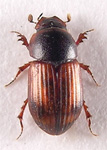
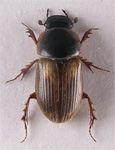







Be assured that this familiarity will soon be gained because at first when working with dung there can be so many specimens that you become overwhelmed and wonder what is worth taking. At first take small samples of things that look as though they might be identifiabe eg. Aphodius and larger histerids or staphs, and then as experience is gained most of these, beyond being added to the field notebook, will be ignored. The variety of species will not be immediately obvious eg. several Aleochara species look similar and it is unlikely that the Sphaeridium you see will all belong to the same species, this kind of thing will become obvious with experience.
Using a stick to overturn a sample may reveal more specimens or it may reveal the presence of Geotrupes (etc.) burrows and at first this method seems to be a good way to obtain specimens but this will almost always overlook the vast majority of the beetles present. To fully appreciate what specimens are present other methods must be used and these will depend on how fresh or wet the sample is. Once a samply begins to dry out it can be seived over a white tray, this is better than a sheet because the sides will help retain the very active staphs, and pulled apart so that the resulting specimens fall through. Similarly a reasonably dry sample can be placed directly in a tray, pulled apart and the specimens pootered. Here you need to be quick as many staphs will fly as soon as they leave the sample, and it is almost certain that as you are pootering a few staphs you will observe Cercyon leisurely unfolding their wings and taking flight from the top of the sample. You will also need a good supply of tubes for the pooter as it is never a good idea to keep the larger staphs with other specimens. Sieving and breaking down samples in trays will provide lots of specimens without too much trouble from reasonably dry or firm samples but this will be of little use with frest ruminant dung which is almost liquid in consistency.
Most of the dung on Croxley moor is from cattle i.e. ruminant dung, and while fresh samples are only useful for what can be netted above them, a range of samples of different ages can always be found and workable ones i.e. dry enough ones, can be used for sampling. There really is no advantage in trying to work through fresh ruminant samples as anything present will very probably be netted around or found amond older samples. As an example Sphaeridium species are very common in fresh ruminant dung and move fast, literally swimming through the sample, and so can be difficult to remove, on the other hand they are also common under older samples that have dried out and can be turned easily. In general the need to work fresh ruminant dung should not arise.
The astonishing thing about dung is how many beetles it can contain and, equally so, how many of these will not be seen as you work through a sample. To fully appreciate this you will need to extract the specimens. Unless you have a convenient water source as eg. the river on Croxley moor, you will need to take the sample home. Choose carefully where to perform the following operation as it can be unsociable, even disregarding the smell; I once turned up at a friend's place soon after a sample had been extracted and it was immediately obvious that the layperson might not appreciate hundreds of staphs etc. around the windows and on the walls. The method we use is to submerge the sample in water and wait for the beetles to float to the surface, which they always do and usually fairly quickly. The sample may need to be weighted down preferably with a large gauge wire mesh to avoid it floating (especially horse dung), do this first and then pour the water gently down the side of the container so that the sample does not fragment or the water discolour too quickly. If this is done carefully the water will remain clear enough to allow identification of many species, this is made easier by the fact that when submerged the elytral colour and patterns are much bolder and easier appreciated, ideally the specimens should be transferred to a shallow tray of water placed ready under a low power (X10) microscope; one of our members 'borrows' a white gratin dish and metal stock strainer for the occasion. Staphs will leave the sample and fly at the first opportunity so some method of retaining these will be needed. We use a twenty litre bucket and, while we have never needed to try this, it seems straightforward enough to fit a wire framework and netting over the top to catch the specimens, this may also negate the need to extract the samples indoors. Failing this a shed with a bright window is ideal.

Bucket Loaded with dung ready for water
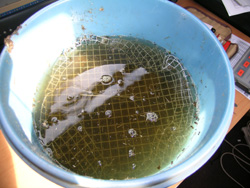
Bucket with water
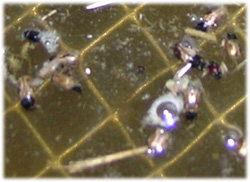
After 5 mins Aphodius and Cercyon
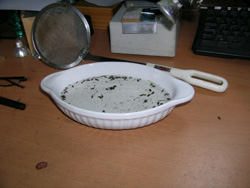
The white dish with Aphodius
Fresh samples are undoubtedly the most productive, on a hot day a sample of a few litres will provide all the specimens needed to become acquainted with the subject. We take samples of about four litres and bring them back to the workshop in a sealed bucket.
Because dung can be so very productive it is best to produce a working plan for the year ahead; sampling from a single locality or habitat may not produce all the dung inhabiting species in any given district, the fauna will change over the year and there will also be longer term changes. Taking three or four samples from three or four sites through the spring, summer and autumn will generate a great deal of work and this must be considered before sampling begins. As an example of what may be involved, one of our members took weekly samples of horse dung from a bridle path in Whippendell Wood during 2007 and, recording only Aphodius species, recorded the following results:
| Ater | 12 | 13 | ||||||||||||||||||||||||||||||||||||||
| Conspurcatus | 1 | |||||||||||||||||||||||||||||||||||||||
| Contaminatus | 23 | 45 | 17 | |||||||||||||||||||||||||||||||||||||
| Erraticus | 1 | |||||||||||||||||||||||||||||||||||||||
| Fimetarius | 1 | 3 | 3 | 1 | ||||||||||||||||||||||||||||||||||||
| Granarius | 1 | |||||||||||||||||||||||||||||||||||||||
| Obliteratus | 4 | 6 | 9 | 20 | 135 | 145 | 130 | 10 | ||||||||||||||||||||||||||||||||
| Prodromus | 4 | 10 | 15 | 130 | 250 | 250 | 430 | 210 | 252 | 56 | 10 | 5 | 1 | 5 | 45 | 130 | 90 | 2 | 20 | 1 | ||||||||||||||||||||
| Pusillus | 1 | 2 | ||||||||||||||||||||||||||||||||||||||
| Rufipes | 1 | 2 | 2 | 3 | 10 | 1 | 9 | 4 | 6 | 1 | 8 | |||||||||||||||||||||||||||||
| Rufus | 1 | 1 | ||||||||||||||||||||||||||||||||||||||
| Sphacelatus | 5 | 6 | 72 | 153 | 110 | 211 | 111 | 136 | 24 | 2 | 1 | 3 | ||||||||||||||||||||||||||||
| Sticticus | 3 | 17 | 177 | 283 | 45 | 250 | 50 | 75 | 120 | 70 | 20 | 25 | 5 | 2 | 2 | 5 | 70 | 140 | 40 | 110 | 320 | 150 | 95 | 10 | 5 | |||||||||||||||
| Zenkeri | 1 | 5 | 5 | 4 | 13 | 10 | 5 | 8 | 4 | 1 | 2 | |||||||||||||||||||||||||||||
| Month | Feb | Mar | Apr | May | Jun | Jul | Aug | Sep | Oct | Nov | ||||||||||||||||||||||||||||||
| Day | 24 | 3 | 10 | 17 | 24 | 31 | 8 | 14 | 21 | 28 | 4 | 11 | 19 | 26 | 2 | 9 | 16 | 24 | 1 | 7 | 14 | 22 | 28 | 5 | 12 | 18 | 25 | 2 | 9 | 16 | 23 | 30 | 7 | 14 | 21 | 28 | 4 | 11 | 18 | 25 |
The great advantage of extracting beetles from dung, as opposed to trapping beetles by using dung as a bait, is that the vast majority of specimens can be released unharmed but it should be realised that extraction may be a very limited method if the object is to record the variety of dung frequenting species occurring in a given area. However thoroughly the specimens are extracted from a sample the results will only represent some of the spatial and temporal activity at that sample over some often unknown period leading up to its collection. Many problems could be overcome by planning a timetable of collecting samples at, say, different times of the day or from different parts of a field etc. but this quickly begins to involve a great deal of work and, in any case, once you are familiar with trying to capture e.g. Creophilus or Ontholestes around an almost liquid cattle dung sample, it will be obvious that such species are most unlikely to be recorded by taking samples of dung for extraction. On the other hand, trapping techniques can, by using dung as a bait be a very good way of retaining such specimens as well as just about anything else that turns up. The number of specimens taken by such traps can be enormous; left for an hour or two on a hot afternoon a dung baited trap may attract hundreds or even thousands of specimens and this is a drawback of the method. Such samples will contain the complete range of species present however active or elusive they may otherwise be; staphs, hydrophilids, scarabaeidae and a whole load of other adventitious species. The trap will also contain LOTS of dung flies (Diptera, Scatophagidae and Sphaeroceridae) and parasitica as well as purely accidental things like Orthoptera and Hemiptera. On a hot summer day these insects will be very active and so some method of retaining them within the trap is needed and this is generally water with an additive such as a drop of detergent or antifreeze to lower the surface tension. This will have no adverse affect on the physical condition of the specimens but it will drown them fairly quickly. The option is to use the traps dry, very optimistically the traps may be packed with material that will provide places for the insects to rest such as is done with egg trays in a moth trap but this kind of thing will quickly be abandoned as really it only offers the larger staphs the opportunity to mutilate each other while everything else takes flight and escapes. Plain water will retain many insects for a while and the majority will survive but this is only a sensible option if the traps are inspected very frequently. The use of water traps should not be ruled out though; spending a few hours working dung pasture can be made more interesting by placing out a few unbaited water traps and doing the rounds every half hour or so. These traps need only be steep sided plastic bowls half filled with water and placed next to dung samples, insects will soon come blundering in. Different colour bowls may attract larger or smaller samples of insects other than dung species and this should be borne in mind.
Dung baited traps are very easy to make and will take many more specimens, a dung sample is placed on a wire mesh resting across the top of an open bucket which is half filled with water, a couple of supporting canes may need to be placed across the bucket to support the weight, and the whole thing left in a likely place. Insects will continue to arrive for as long as the dung is attractive. Burying the bucket flush with the ground has the advantages that it will also act as a pitfall trap as well as help avoid the attention of the public.
The disadvantage of this method is that the traps will need to be visited on a regular and frequent basis and it is very likely that they will contain large samples of insects; common species may be present in hundreds or even thousands and so some exploratory work should be done beforehand to assess the likely nature of samples to come. Working part-time to record the local fauna it is highly unlikely that one person would be able to cope with very many samples; before such trapping is performed it really will be necessary to perform a few brief and supervised trial runs in varying conditions so that you are aware of the potential work that might be involved. But the advantages are so great as to justify the work should one be dedicated enough to act in such a way. As well as revealing more of the variety of species occurring in a particular area traps can be used to demonstrate the successional nature of various species at a sample e.g. dung flies and some staphs may arrive within minutes of a sample being deposited and some of these staphs e.g. Tachinus spp., Oxytelus laqueatus, Philonthus marginatus and Aleochara spp. may within fifteen minutes be present in large numbers. Among the first dung beetles to arrive are usually Aphodius prodromus (Brahm), A. sphacelatus (Panzer) and A. rufipes (L.) along with species of the hydrophilid genera Sphaeridium and Cercyon (Gittings and Giller,1998). Among these early arrivals it is easy enough to demonstrate that some turn up at different times of the day to others e.g. A. rufipes (L.) is generally an evening flier. Aphodius rufus (Moll.) and A. ater (DeGeer) usually arrive when the sample is a little older and are referred to as mid-successional species while A. fimetarius (L.) and A. fossor (L.) are late successional species. A series of traps sited among dung samples of various ages and on various soil types may produce different species e.g. Sphaeridium spp. can exploit dung too wet for some other species, Cercyon spp. are more abundant in moister dung whereas some Aphodius such as ater, fimetarius and fossor prefer to oviposit in drier dung (Gittings and Giller ibid). Series of insect samples from baited traps may thus be used to record succession and temporal activity associated with a particular dung sample, seasonal occurrence of species can be demonstrated from a regular sampling regime and even movement of species can be followed if time allows. Dung traps should also be used away from dung pasture; sometimes the most ostensibly unpromising sites will yield dung species even though dung appears to be absent e.g. Cercyon Spp. develop in decaying vegetable matter generally while Aphodius prodromus (Brahm) and A. sphacelatus (Panzer) among others are known to develop on subterranean plant matter (Gittings and Giller ibid).
Taking the insect samples from these traps is simple enough; a strainer can be used to remove the insects from the water or, more thoroughly, the water can be poured through the strainer or a much better method is to carry a few pieces of nylon curtain type mesh about 25cm square through which the liquid can be poured, these can then be sealed along with the insect sample into small jars for later inspection, for convenience the sample data can be chinagraphed onto the base of the jars.
This sort of sampling is at best a very powerful research tool for entomologists working at all levels, for the rather simple purpose of recording a local fauna all of the methods discussed will provide an abundance of material and a great deal to occupy the recorder. It must also be realised that at worst these methods can be highly destructive in terms of the numbers of insects they produce if they are not implemented both very sensibly and carefully and the effort to deal with these specimens is not made before the samples taken. When starting out and without guidance from a seasoned biologist it is very likely that a couple of samples, or even a single �good� sample will provide enough material for a whole winter�s worth of identifying and mounting and classifying and all the other stuff that makes entomology so rewarding, this will leave little time for all the other fantastic groups of beetles and methods ready to be explored so at first go and take the odd sample and have a good look at things in order to gain some expertise so that, when you do become obsessed with these intensely fascinating things, you will be better equipped to deal with them.
� When running a moth trap in a west London garden in the 1970's I often recorded over a hundred species and more than a thousand specimens during a single night but unfortunately the data and lists have not survived. More recent trapping at the same site during may and june 2005 produced a maximum of twenty specimens of just six species.
References
Gittings, T. and Giller, P.S. (1977). Life history traits and resource utilisation in an assemblage of north temperate Aphodius dung beetles. Ecography 20:55-56.